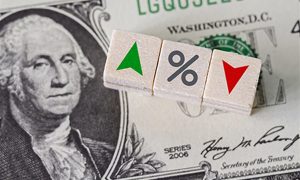Concerns over inflation continue to be a hot issue in the economic recovery from the COVID-19 pandemic. But what is inflation? And should you be worried about it?
This post will break down inflation in simple terms and explain how concerned you should be.
Basic Definition – What is Inflation?
In economic terms, inflation is the decrease in purchasing power—or value—of money. It’s generally measured as an increase in the price of goods and services.
If a loaf of bread cost $3 one year ago and then costs $6 today, we can surmise that one of two things happened in the past year:
- An event occurred that specifically affected bread – either higher demand for bread or a lower supply of ingredients, etc.
- An economy-wide event occurred that decreased the purchasing power of money. A dollar simply isn’t as valuable today as it once was, and therefore it takes more dollars to buy bread
Looking at bread alone, it’s difficult to determine which of these two explanations is true. An important detail regarding inflation is that it affects the entire economic system, not just one product. We’re all familiar with how gas prices can fluctuate on a daily basis. Those changes are not inflation. They are short-term changes typically based on supply and demand.
This brings us to our next question: how do we actually measure inflation?
How Do We Measure Inflation?
Since inflation affects the entire economy, we need to collect data across the entire economy in order to find and measure inflation. What kind of data? Just think about it…what are all the things you spend money on?
Let’s take a look at your budget. There’s housing and transportation. Food is a big category, too. We also spend money on medicine, recreation, and professional services. We each spend money on many different items, and we need to look at pricing data for all those items to truly understand the effect of inflation.
The U.S government—and many other national governments—agree with this idea. They measure something called the consumer price index, or CPI. The U.S. Bureau of Labor Statistics (BLS) measures the prices of a “basket of goods” on a monthly frequency. The “basket” itself contains over 80,000 items coming from eight major categories:
- Housing
- Food and Beverage
- Medical Care
- Recreation
- Apparel
- Transportation
- Education and Communication
- Other Goods and Services
The BLS calculates the CPI by taking a weighted average of those 80,000 items.
Inflation is measured by calculating the change in CPI between time periods. For example, the rate of inflation for 2017 and 2018 was measured by comparing those years’ CPIs against the 2014 and 2015 CPIs, respectively.
What Are Historical Inflation Rates?
The BLS has been measuring CPI every year since 1913, so we have accurate inflation dating back to over a century ago. The historical average inflation in the United States is 3.2% per year.
Granted, there have been individual years with significantly different inflation rates. For example, there was a famous bout of high inflation in the 1970s and early 1980s, which saw many years of inflation over 10%! On the other side of the coin, there have been periods of negative inflation a.k.a. deflation. We’ll discuss the problems of high inflation and deflation later on.
More recently, inflation has been lower than the historical average of 3.2%. Combining the 1990s, the 2000s, and the 2010s, the recent average inflation rate has been 2.4%.
That’s why many financial professionals plan for the future using an “expected” annual inflation rate between 2.5% and 3.0%. It’s a balance between the entire historical data set and the recent historical data set.
But we’re still missing a key piece to answering ‘what is inflation?’ Namely, what causes inflation?
What Causes Inflation?
Many economists agree that inflation is easy to identify in hindsight, but is difficult to predict beforehand. However, they will admit that almost all instances of inflation share one common trait: inflation is caused by an increase in the money supply in an economy.
This makes sense, especially if we examine it through the lens of supply, demand, and value. Supply and demand dictate that if the supply of a product goes up while the demand stays stagnant, then the value (or price) of that product will decrease. Too much supply, the price goes down.
When more money is added to an economy, the same principle of supply and demand applies. The supply of money increases. But the economy is still only producing the same stuff as before—the demand for that stuff hasn’t changed.
There’s more money spread across the same amount of stuff. And thus, the price of that stuff increases! That’s what inflation is!
But the exact mechanisms of inflation can be confusing, and there’s frequent debate about how it really works. Let’s discuss three popular mechanisms for explaining inflation.
1. Demand-Pull Inflation
Demand-pull inflation occurs when the rise in demand for goods and services is greater than the rise in the supply of those goods and services. Basic economics dictates that when demand outpaces supply that prices increase. And those increasing prices are inflation.
Let’s look at a present-day example. As America reopens after COVID-19, we are seeing two major contributors to increasing demand.
First, there have been multiple waves of monetary stimulus that have put extra money into consumers’ hands. Second, there are behavioral aspects at play—we’ve been living limited lifestyles for over a year and now want to break free.
The demand for certain goods and services is rapidly rising. And we’re seeing prices rise too.
2. Cost-Push Inflation
The demand-pull hypothesis starts with the consumer (and their demand) and then pulls the producer’s prices higher. Now let’s look at the opposite hypothesis. The cost-push explanation of inflation says that increasing costs of production force producers to increase their prices, regardless of the consumers’ demand.
For example, we’ve seen commodity shortages recently. Lumber is a perfect example. The cost of building a new house has risen due to this shortage. Those rising costs are passed onto homebuyers, and the rising prices of homes will affect the CPI.
3. Built-In Inflation
While demand-pull and cost-push have tangible explanations, the final theory—called built-in inflation—is more about expectations than reality.
Some economists believe that people now expect inflation, regardless of any changes to supply or demand. And because of these expectations, workers want higher wages each year. Businesses expect higher costs each year. And those same businesses set higher prices each year. That’s ok with the consumer because they expect higher prices each year.
This theory posits that everyone is on the same page: we all expect inflation. Even if there’s no true supply or demand issue, inflation will invariably work its way into the economy.
Why is Inflation Bad?
Why is inflation viewed in a negative light?
For starters, inflation reduces the average person’s spending power. Let’s say you have $12,000 in the bank. That’s great! If your family spends $4,000 per month, that means you have enough money to cover three full months of living expenses.
That’s a healthy emergency fund.
Let’s fast forward 10 years. Our $12,000 grows by about 0.5% per year (based on current interest rates in high-yield savings accounts). It grows to $12,600. But our spending also increases by the rate of inflation, which we’ll say is the aforementioned 2.4% per year. We now have to spend $5,000 per month on living expenses instead of $4,000.
Our $12,600 emergency fund now only covers 2.5 months of $5,000 living expenses.
We did nothing wrong. We didn’t lose money. We didn’t spend the money. In fact, the interest from our savings account actually gave us some money. And yet we lost ground to inflation. That is why many people despise inflation.
But inflation isn’t always a bad thing.
For starters, let’s look at deflation—the opposite of inflation. Deflation is associated with a shrinking economy, recessions, and all-out economic depressions. In hard times, people generally have less money to spend. They buy less, they demand less, and prices drop. Producers are hurt too since their cash flow decreases. Deflation is a sign of economic pain.
Inflation, on the other hand, is a sign of growth. Money is plentiful, so much so that demand is rising and wages are increasing. While inflation hurts the idle money in your bank, it’s a sign of positivity for the larger economy.
Examples of Recent Inflation and Potential Future Inflation
Let’s take a look at how inflation has affected consumer prices in recent years. Remember – inflation describes the overall increase in price across more than 80,000 tracked items and expenses. But by looking at individual items, we garner a better understanding of how inflation affects our daily lives.
1. Coffee
Who doesn’t like a cup of joe? Mmmm! Scalding hot, bitter bean water.
In 1980, one pound of ground coffee cost $3.14 per pound. Today, that same pound of coffee costs $4.43 per pound.
That means that coffee prices have inflated by an annual average of 0.86% per year—much less than the average inflation during this time period. This suggests that the coffee industry as a whole has gotten more competitive and more efficient. And that benefits the consumer!
2. Cars
The quintessential American purchase—the first car! We should probably start telling people how expensive driving is and that their cars are money pits. But I digress…
An average car in 1980 cost about $7,000. According to Kelley Blue Book, the average new car in 2020 cost about $38,000. Granted, those two cars are vastly different. Whereas coffee beans haven’t changed much in 40 years, car technology has rapidly advanced. Nevertheless, let’s see how much car costs have increased…
It takes a 443% total increase in price to jump from $7,000 to $38,000, which is equivalent to a 4.3% increase per year. Cars have increased in price more than the typical consumer item. But then again, we are getting a better product thanks to advances in car technology.
3. Gasoline
It’s everyone’s favorite consumer good to be concerned about: gasoline!
Gas prices are constantly fluctuating due to varying levels of supply (from the oil industry) and demand (from many different places, including consumer travel). While daily fluctuations are likely not caused by monetary inflation, long-term trends can expose prior inflation.
In 1980, one gallon of gas cost about $1.20. And as of this writing, that same gallon costs about $3.05 (U.S. average). The price, therefore, has inflated by 2.36% per year for the past 40 years—which is almost exactly the same as the larger economic inflation rate.
How Could Inflation Affect Us in the Future?
People are worried about inflation right now. In April 2021, for example, the CPI was 4.2% higher than April 2020. That’s a larger-than-expected increase, and people are worried that the increasing trend will continue. People are pointing to the COVID-19 recovery and monetary stimuli as the proximate cause.
What if we have a decade of 4 or 5% inflation. Where will we be in ten years?
For starters, the CPI would be about 55% higher than it is now (assuming 4.5% inflation, ten times in a row).
If every product was affected evenly (which we know isn’t true, but is a useful mental model), then:
- Today’s $5.00 coffee will cost close to $8.00
- Today’s $50.00 gas fill-up will cost close to $80.00
- Today’s $1500 monthly rent will cost more than $2300
- Today’s $200 grocery bill will cost over $300
- The same person who spent $4000 per month would need to spend over $6000 for the same lifestyle
And if your money is just sitting in the bank, it will be losing its buying power. But we aren’t helpless. There are ways to protect against inflation.
How to Protect Against Inflation?
Below are a few tried-and-true ways to protect oneself against inflation.
1. Keep Minimal Money in Cash
First and foremost, the best way to protect against inflation is to keep your cash stockpile to a minimum. Most experts recommend you keep cash as an emergency fund, but no more than that.
2. Invest in Stocks
Investing in stocks is a good hedge against inflation. Why? Because businesses are rarely punished by inflation. While it’s true that inflation can push their costs higher, it also pushes their revenues higher. Thus, the overall effect is neutral.
Investing in stocks is still a smart move despite all-time high prices.
3. Invest in TIPS
TIPS stands for Treasury Inflation-Protected Securities. It is a type of treasury bond that is intentionally indexed against the CPI. If you bought $1000 worth of TIPS today and then we suffered 50% inflation over the next decade, then the principal of the TIPS would increase to $1500—completely negating the inflation!
On top of that increasing principal, you’d also receive interest payments, also called “coupons.”
TIPS won’t make you rich, but they’re designed to protect you against inflation.
4. Gold, Bitcoin, & More
Many investors point to gold as the classic hedge against inflation. The logic is, “It’s easy to print more money, but it’s way harder to create more gold.” Gold is a steadfast store of value even as the volume of money swells up around it.
But one problem with gold is that it produces zero cash flow. Unlike stocks (which produce dividends) and TIPS (which produce coupons), a lump of gold just sits there…producing nothing! Nevertheless, gold provides diversification in an inflation-hedged portfolio.
Though Bitcoin is still young and relatively untested, many people believe it has a role to play that’s similar to gold. Part of the Bitcoin software protocol is that there can only be a finite number of Bitcoin ever produced (around 21 million BTC).
That finite cap, in theory, gives Bitcoin a defined value that is impervious to inflation.
That’s why Bitcoin enthusiasts laud its inflation protection when they explain Bitcoin’s uses.
Final Thoughts
Inflation is an intrinsic part of our current economic system. That’s both good and bad. It can steal our dollars’ value, but it’s a sign of widespread economic growth—and that benefits us all. And when concerns arise, we can usually protect ourselves from inflation’s grasp using tested investment methods.
The post Should you be worried about inflation? appeared first on Mediafeed.org
Original source: Mediafeed.org






